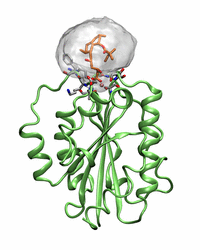
Simvastatin acts as a stopper, plugging the adhesion molecules in the immune system.
Simvastatin, which is one of the most commonly used pharmaceuticals in the world, also has a beneficial effect on the immune defense system with regard to diseases such as type 1 diabetes, multiple sclerosis and rheumatoid arthritis. Danish researchers have now explored why this is so, and their findings may result in improved treatment.
In the case of multiple sclerosis, the immune defense system destroys the central nervous system, while the inflammation affects the kidneys, eyes and sense of touch in both type 1 and type 2 diabetes, leading to a variety of complications...
Read More




![Synthesis of cyclotides. Cyclotides were assembled as linear precursors using FMOC chemistry, and cyclized using native chemical ligation. (1) Dawson’s resin containing di-Fmoc-3,4-diaminobenzoic acid (Dbz) as linker is the starting point. (2) Couplings are performed using microwave-assisted FMOC synthesis (asterisk marks the first amino acid; the last amino acid is a BOC-protected cysteine). (3) Acylation and activation of the resin bound Dbz-precursor to yield the N-acylurea peptide (Nbz-peptide). (4) Full deprotection and resin cleavage of the Nbz-peptide in one step (Ar, Aryl). Peptide cyclization (5a) via thioesterification, (5b) S, N-intramolecular acyl shift and native chemical ligation and (5c) oxidative folding to yield cyclotides with the native fold. Ribbon representation of a cyclotide (kalata B1, PDB ID code 1NB1) and sequence of [T20K]kalata B1 are shown. Cysteines, disulfide bonds (yellow), and intercysteine loops are indicated.](https://www.pnas.org/content/early/2016/03/22/1519960113/F1.medium.gif)



Recent Comments